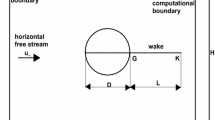Abstract
The essence of the Prandtl rule consists in the fact that in a flow at a Mach number M < 1 the transverse dimensions of a sharp-ended slender body must be reduced by a factor of 1/(1 - M2)1/2 to conserve the same pressure distribution over the body surface as in a flow with the same velocity at M=0.
Following Prandtl [1], the derivation is repeated with reference to axisymmetric flow with developed cavitation.
Similar content being viewed by others
References
L. Prandtl, Führer durch die Strömungslehre, Braunschweig (1956).
L.G. Loitsyanskii, Mechanics of Liquids and Gases, Pergamon Press, Oxford (1966).
A. D. Vasin, “Slender axisymmetric cavities in a subsonic compressible fluid flow,” Izv. Akad. Nauk SSSR, Mekh. Zhidk. Gaza, No. 5, 174 (1987).
G.V. Logvinovich, “Problems of the theory of slender axisymmetric cavities,” Tr. TsAGI, No. 1797 (1976).
G.V. Logvinovich, “Law of expansion of an unsteady cavity,” Prikl. Gidromekhanika, 2 (74), No. 3 (2000).
M. I. Gurevich, “Finite-drag half-body in a subsonic flow,” Tr. TsAGI, No. 653 (1947).
Rights and permissions
About this article
Cite this article
Logvinovich, G.V. Subsonic Compressible Flow Past a Body with Developed Cavitation. Fluid Dynamics 37, 873–876 (2002). https://doi.org/10.1023/A:1022392011614
Issue Date:
DOI: https://doi.org/10.1023/A:1022392011614



